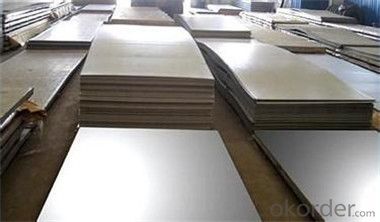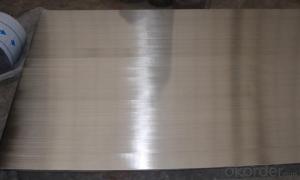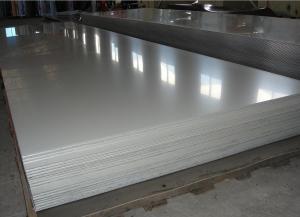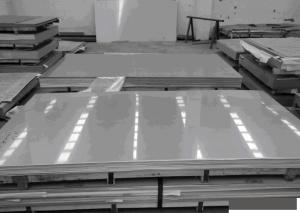Stainless Steel Sheet 304 with Best Quality in China
- Loading Port:
- Tianjin
- Payment Terms:
- TT OR LC
- Min Order Qty:
- 50 m.t.
- Supply Capability:
- 45555555 m.t./month
OKorder Service Pledge
OKorder Financial Service
You Might Also Like
Item specifice
Description of stainless steel plate:
stanless steel sheet roll
Manufacturer since 2003;
Origin from Baosteel & Tisco;
100% Manufacture's direct deal.
Festures of stainless steel plate:
Material: 201
Finish: 2B, BA, No.4, HL
Thickness: 0.2mm~2.5mm
Size: 1000*2000mm,1219*2438mm or as per customers' request
Application: Kitchenware, decoration, construction and building ornament, product parts manufacturing and stainless steel products tooling and so on
Specifications of stainless steel plate:
Product Name | cr 1219x2438 stanless steel sheet 201 |
standared | JIS, AISI, ASTM, GB, DIN,SUS |
Thickness | 0.2mm~2.5mm |
Size | 1000*2000mm,1219*2438mm or as per customers' request |
Surface finish | 2B, BA, Hair Line, No.1,No.4, Mirror Finish |
Application | Kitchenware, decoration construction and building ornament, product parts manufacturing and stainless steel products tooling and so on |
Payment terms | T/T 30% for deposit, Balance against the copy of B/L; or L/C at sight |
Product Packing | wooden pallet |
Delivery time | within 15-20 working days after we got your 30% deposit |
Attention | FREE SAMPLES can be sent on request. We promise to provide our valued clients with high quality products, low price, and excellent client services. |
Images of stainless steel plate:

FAQ:
1. What is your package?
Packing situation: standard seaworthy packing or as customer required.
2. How long is the lead time?
Delivery time: 45 days after order confirmed.
3. What payment term do you accept?
Payment: T/T or L/C at sight.
- Q:What are the main factors influencing the choice of steel wire rod order quantity?
- The main factors influencing the choice of steel wire rod order quantity include market demand, production capacity, lead time, inventory holding costs, and pricing dynamics. Firstly, market demand plays a crucial role in determining the order quantity of steel wire rods. Companies need to assess the current and future demand trends in their target markets to ensure they meet customer requirements without overstocking or facing shortages. Accurate demand forecasting is essential to optimize the order quantity. Secondly, the production capacity of the supplier or manufacturer is a critical factor in determining the order quantity. Companies need to evaluate the supplier's capabilities to meet their required quantity within the desired timeframe. If the supplier has limited production capacity, it may impact the order quantity decision. Lead time, which refers to the time taken from placing an order to receiving the goods, is another influential factor. Longer lead times may require companies to order larger quantities to ensure an uninterrupted supply chain. Conversely, shorter lead times may allow for smaller order quantities, reducing inventory carrying costs. Inventory holding costs comprise expenses associated with storing and managing inventory. Companies need to consider these costs while deciding the order quantity. Ordering excessive quantities may lead to higher holding costs, including storage, insurance, and obsolescence, while ordering insufficient quantities may result in stockouts and potentially lost sales. Lastly, pricing dynamics can influence the order quantity of steel wire rods. Bulk purchasing often leads to better pricing terms, discounts, or rebates. Therefore, companies may consider ordering larger quantities to take advantage of favorable pricing conditions. However, they must carefully evaluate the trade-off between potential cost savings and inventory carrying costs. In conclusion, the main factors influencing the choice of steel wire rod order quantity are market demand, production capacity, lead time, inventory holding costs, and pricing dynamics. By considering these factors, companies can optimize their order quantity decisions to ensure an efficient supply chain and meet customer requirements effectively.
- Q:What are the different types of wire baskets and containers made from steel wire rod?
- There are several types of wire baskets and containers made from steel wire rod, including wire mesh baskets, wire storage bins, wire laundry hampers, and wire food storage containers. These baskets and containers are commonly used for storing and organizing various items in homes, offices, and industrial settings. They are known for their durability, lightweight design, and excellent ventilation properties.
- Q:How is steel wire rod classified based on its carbon content?
- Steel wire rod can be classified based on its carbon content into three main categories: low carbon wire rod, medium carbon wire rod, and high carbon wire rod. Low carbon wire rod typically contains carbon levels ranging from 0.05% to 0.15%. It is characterized by its high ductility and excellent formability. This type of wire rod is commonly used in applications that require flexibility and bending, such as in the manufacturing of wires for fencing, nails, and construction materials. Medium carbon wire rod contains carbon levels ranging from 0.15% to 0.45%. It possesses higher strength and hardness compared to low carbon wire rod. Medium carbon wire rod is often used in applications that require both strength and flexibility, such as in the production of automotive parts, springs, and certain types of fasteners. High carbon wire rod has carbon levels ranging from 0.45% to 0.85%. It is known for its exceptional strength and hardness. High carbon wire rod is typically used in applications that require maximum strength, such as in the production of high-tensile wires used for suspension bridges, pre-stressed concrete structures, and wire ropes used in heavy machinery. The classification of steel wire rod based on carbon content allows manufacturers and consumers to choose the appropriate grade of wire rod for their specific needs, considering factors such as strength, flexibility, and durability requirements.
- Q:How is steel wire rod used in the manufacturing of wire rope shackles?
- Steel wire rod is a primary raw material used in the manufacturing of wire rope shackles. It is first processed into wire by drawing it through a series of dies to reduce its diameter. This wire is then further processed, typically by forging or machining, to create the individual components of the wire rope shackles, such as the body, pin, and clevis. These components are then assembled and secured using various techniques, including welding or threaded connections, to form the final wire rope shackles.
- Q:What are the safety considerations when handling steel wire rod?
- When handling steel wire rod, it is important to consider several safety measures. Firstly, proper personal protective equipment (PPE) such as gloves, safety glasses, and steel-toed boots should be worn to protect against potential injuries. Additionally, workers should be trained on safe lifting techniques and ensure that the weight of the steel wire rod is within their physical capabilities. It is crucial to maintain a clean and organized work area to prevent trips, slips, and falls. Workers should also be cautious of sharp edges and points on the wire rod, using appropriate tools and handling methods to avoid cuts or punctures. Lastly, proper storage and handling practices should be followed to prevent the wire rod from rolling or falling, potentially causing injuries to workers or damage to property.
- Q:How is steel wire rod used in the manufacturing of screws and bolts?
- Steel wire rod is an essential component in the manufacturing process of screws and bolts. It serves as the raw material from which these fasteners are formed. The steel wire rod undergoes a series of manufacturing processes to transform it into screws and bolts. Firstly, the steel wire rod is heated to a high temperature to soften it. This process, known as annealing, makes the wire rod more malleable and easier to work with. Once the wire rod is heated, it is then passed through a series of dies to shape it into the desired form. These dies are specifically designed to create the thread pattern of the screw or bolt. After the wire rod has been shaped, it is cut into appropriate lengths to form individual screws or bolts. These lengths are then further processed to add the necessary features, such as the head shape and slot or recess for screwdrivers. In some cases, the wire rod may also be treated with various coatings or finishes to enhance its durability and corrosion resistance. The use of steel wire rod in the manufacturing of screws and bolts offers several advantages. Steel is known for its strength and durability, making it an ideal material for fasteners that need to withstand high levels of stress or tension. Additionally, steel wire rod is readily available and cost-effective, making it a popular choice for mass production. In conclusion, steel wire rod plays a vital role in the manufacturing of screws and bolts. It serves as the starting material, which is shaped and processed to create the final product. The use of steel wire rod ensures that screws and bolts are strong, durable, and able to fulfill their intended purpose in various applications.
- Q:What are the different wire drawing lubricants used for steel wire rod?
- There are several different wire drawing lubricants used for steel wire rod, including soap-based lubricants, oil-based lubricants, and synthetic lubricants. Soap-based lubricants are commonly used for mild steel wire rod, as they provide good lubrication and cooling properties. Oil-based lubricants are often used for high carbon and alloy steel wire rod, as they offer better lubrication and reduce friction during the drawing process. Synthetic lubricants, such as water-based polymer lubricants, are also used to improve surface finish and reduce wear on the wire rod during drawing.
- Q:How is steel wire rod used in the manufacturing of wire forms for agricultural machinery?
- Steel wire rod is a crucial component in the manufacturing of wire forms for agricultural machinery. It serves as the raw material that is transformed into various wire forms such as springs, clips, brackets, and hooks, which are essential for the proper functioning of agricultural machinery. One of the primary uses of steel wire rod in the manufacturing process is to create springs. Springs are widely used in agricultural machinery to provide tension, absorb shocks, and facilitate smooth movement. These springs are made by coiling steel wire rod into the desired shape and size, and they play a vital role in ensuring the functionality and durability of agricultural machinery. Additionally, steel wire rod is also used to create various clips, brackets, and hooks that are essential for securing different components of agricultural machinery. These wire forms are typically bent, twisted, or shaped using the steel wire rod to provide the necessary strength and stability required for agricultural machinery to withstand the demanding conditions of farming operations. Moreover, steel wire rod is known for its high tensile strength, which makes it an ideal material for manufacturing wire forms used in agricultural machinery. It can withstand heavy loads, resist deformation, and provide the necessary support and reinforcement required to enhance the performance and longevity of the machinery. In summary, steel wire rod is used extensively in the manufacturing of wire forms for agricultural machinery. It is utilized to create springs, clips, brackets, and hooks, which are essential components for the proper functioning, stability, and durability of agricultural machinery. The high tensile strength of steel wire rod makes it a reliable material choice for manufacturing wire forms that can withstand the demanding conditions of agricultural operations.
- Q:What are the applications of steel wire rods?
- Steel wire rods have a wide range of applications in various industries such as construction, automotive, manufacturing, and infrastructure. They are commonly used for reinforcement in concrete structures, such as bridges and buildings, as well as in the production of wire ropes, springs, nails, and fencing materials. Additionally, steel wire rods are utilized in the manufacturing of automotive parts, electrical cables, and various machinery components, highlighting their versatility and importance in modern industries.
- Q:How are steel wire rods used in the production of wire ropes for elevators?
- Steel wire rods are used as the primary material for producing wire ropes for elevators. These rods are first drawn into long, thin wires that are then twisted or braided together to form a strong and flexible rope. The high tensile strength and durability of steel make it ideal for ensuring the safety and reliability of elevator systems.
1. Manufacturer Overview |
|
|---|---|
| Location | |
| Year Established | |
| Annual Output Value | |
| Main Markets | |
| Company Certifications | |
2. Manufacturer Certificates |
|
|---|---|
| a) Certification Name | |
| Range | |
| Reference | |
| Validity Period | |
3. Manufacturer Capability |
|
|---|---|
| a)Trade Capacity | |
| Nearest Port | |
| Export Percentage | |
| No.of Employees in Trade Department | |
| Language Spoken: | |
| b)Factory Information | |
| Factory Size: | |
| No. of Production Lines | |
| Contract Manufacturing | |
| Product Price Range | |
Send your message to us
Stainless Steel Sheet 304 with Best Quality in China
- Loading Port:
- Tianjin
- Payment Terms:
- TT OR LC
- Min Order Qty:
- 50 m.t.
- Supply Capability:
- 45555555 m.t./month
OKorder Service Pledge
OKorder Financial Service
Similar products
New products
Hot products
Related keywords




























